
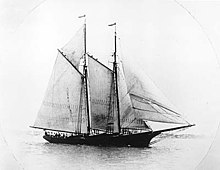

A fore-and-aft rig is a sailing vessel rigged mainly with sails set along the line of the keel, rather than perpendicular to it as on a square rigged vessel. [2]



A fore-and-aft rig is a sailing vessel rigged mainly with sails set along the line of the keel, rather than perpendicular to it as on a square rigged vessel. [2]
Fore-and-aft rigged sails include staysails, Bermuda rigged sails, gaff rigged sails, gaff sails, gunter rig, lateen sails, lug sails, tanja sails, the spanker sail on a square rig and crab claw sails.
Fore-and-aft rigs include:
Barques and barquentines are partially square rigged and partially fore-and-aft rigged.
A rig which combines both on a foremast is known as a hermaphroditic rig.
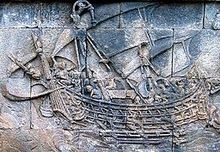
The fore-and-aft rig is believed to have been first developed independently by the Austronesian peoples some time around 1500 BC with the invention of the crab claw sail. It is suggested that it evolved from a more primitive V-shaped "square" sail with two spars that come together at the hull. Crab claw sails spread from Maritime Southeast Asia to Micronesia, Island Melanesia, Polynesia, and Madagascar via the Austronesian migrations. [3] Austronesians in Southeast Asia also later developed other types of fore-and-aft sails, such as the tanja sail (also known as the canted square sail, canted rectangular sail, or the balance lug sail). [3]
Their use later spread into the Indian Ocean since the first millennium, among vessels from the Middle East, South Asia, and China. [4] [5]
The square rig had predominated in Europe since the dawn of sea travel, but in the generally gentle climate of southern Europe and the Mediterranean Sea during the last few centuries before the Renaissance the fore-and-aft began to replace it. By 1475, its use increased, and within a hundred years the fore-and-aft rig was in common use on rivers and in estuaries in Britain, northern France, and the Low Countries, though the square rig remained standard for the harsher conditions of the open North Sea as well as for trans-Atlantic sailing.
The triangular lateen sail was more maneuverable and speedier, while the square rig was labor-intense but seaworthy.
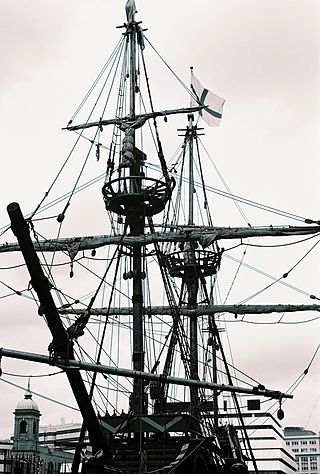
Rigging comprises the system of ropes, cables and chains, which support and control a sailing ship or sail boat's masts and sails. Standing rigging is the fixed rigging that supports masts including shrouds and stays. Running rigging is rigging which adjusts the position of the vessel's sails and spars including halyards, braces, sheets and vangs.

A sailing ship is a sea-going vessel that uses sails mounted on masts to harness the power of wind and propel the vessel. There is a variety of sail plans that propel sailing ships, employing square-rigged or fore-and-aft sails. Some ships carry square sails on each mast—the brig and full-rigged ship, said to be "ship-rigged" when there are three or more masts. Others carry only fore-and-aft sails on each mast, for instance some schooners. Still others employ a combination of square and fore-and-aft sails, including the barque, barquentine, and brigantine.

A sailing vessel's rig is its arrangement of masts, sails and rigging. Examples include a schooner rig, cutter rig, junk rig, etc. A rig may be broadly categorized as "fore-and-aft", "square", or a combination of both. Within the fore-and-aft category there is a variety of triangular and quadrilateral sail shapes. Spars or battens may be used to help shape a given kind of sail. Each rig may be described with a sail plan—formally, a drawing of a vessel, viewed from the side.

A brigantine is a two-masted sailing vessel with a fully square-rigged foremast and at least two sails on the main mast: a square topsail and a gaff sail mainsail. The main mast is the second and taller of the two masts.
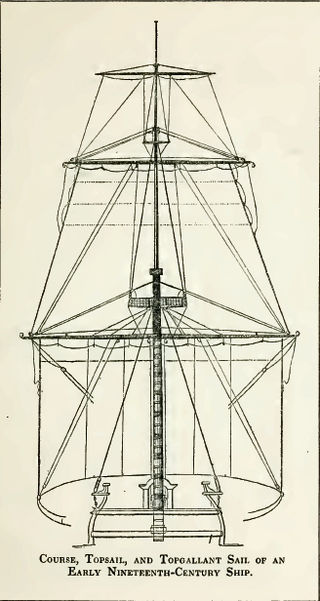
A topsail ("tops'l") is a sail set above another sail; on square-rigged vessels further sails may be set above topsails.
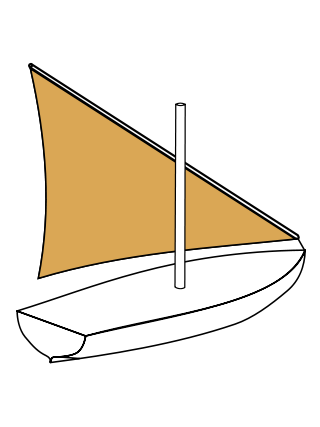
A lateen or latin-rig is a triangular sail set on a long yard mounted at an angle on the mast, and running in a fore-and-aft direction. The settee can be considered to be an associated type of the same overall category of sail.

Running rigging is the rigging of a sailing vessel that is used for raising, lowering, shaping and controlling the sails on a sailing vessel—as opposed to the standing rigging, which supports the mast and bowsprit. Running rigging varies between vessels that are rigged fore and aft and those that are square-rigged.

A yard is a spar on a mast from which sails are set. It may be constructed of timber or steel or from more modern materials such as aluminium or carbon fibre. Although some types of fore and aft rigs have yards, the term is usually used to describe the horizontal spars used on square rigged sails. In addition, for some decades after square sails were generally dispensed with, some yards were retained for deploying wireless (radio) aerials and signal flags.

A Bermuda rig, Bermudian rig, or Marconi rig is a configuration of mast and rigging for a type of sailboat and is the typical configuration for most modern sailboats. This configuration was developed in Bermuda in the 1600s; the term Marconi, a reference to the inventor of the radio, Guglielmo Marconi, became associated with this configuration in the early 1900s because the wires that stabilize the mast of a Bermuda rig reminded observers of the wires on early radio masts.
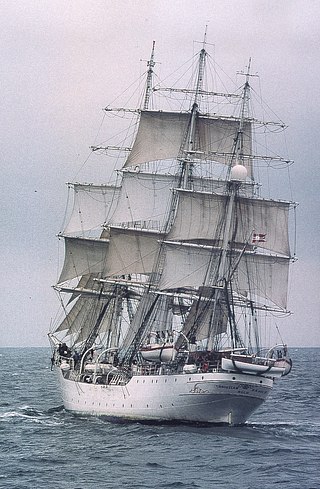
A full-rigged ship or fully rigged ship is a sailing vessel with a sail plan of three or more masts, all of them square-rigged. Such a vessel is said to have a ship rig or be ship-rigged, with each mast stepped in three segments: lower, top, and topgallant.

A polacca is a type of seventeenth- to nineteenth-century sailing vessel, similar to the xebec. The name is the feminine of "Polish" in the Italian language. The polacca was frequently seen in the Mediterranean. It had two or three single-pole masts, the three-masted vessels often with a lateen hoisted on the foremast and a gaff or lateen on the mizzen mast. The mainmast was square-rigged after the European style. Special polaccas were used by Murat Reis, whose ships had lateen sails in front and fore-and-aft rig behind.

The spritsail is a four-sided, fore-and-aft sail that is supported at its highest points by the mast and a diagonally running spar known as the sprit. The foot of the sail can be stretched by a boom or held loose-footed just by its sheets. A spritsail has four corners: the throat, peak, clew, and tack. The Spritsail can also be used to describe a rig that uses a spritsail.

The crab claw sail is a fore-and-aft triangular sail with spars along upper and lower edges. The crab claw sail was developed in Island Southeast Asia some time before 2000 BCE. It went on to be used in many traditional Austronesian cultures in Island Southeast Asia, Micronesia, Island Melanesia, Polynesia, and Madagascar. Wind tunnel testing has shown it has impressive performance compared with the yardstick of Bermuda rig, with the vortices formed by the sail being suggested as a reason for the difference. It is sometimes known as the Oceanic lateen or the Oceanic sprit, even though it is not restricted to Oceania, is neither a lateen sail nor a spritsail, and has an independent older origin.

A sail is a tensile structure, which is made from fabric or other membrane materials, that uses wind power to propel sailing craft, including sailing ships, sailboats, windsurfers, ice boats, and even sail-powered land vehicles. Sails may be made from a combination of woven materials—including canvas or polyester cloth, laminated membranes or bonded filaments, usually in a three- or four-sided shape.
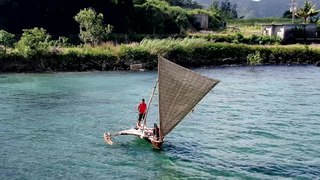
Kaep is a traditional type of double-ended Proa sailboat native to Palau. Some of the essential design elements have also been adopted as a modern smaller multihull prototype variant.
The following outline is provided as an overview of and topical guide to sailing:

The lug sail, or lugsail, is a fore-and-aft, four-cornered sail that is suspended from a spar, called a yard. When raised, the sail area overlaps the mast. For "standing lug" rigs, the sail may remain on the same side of the mast on both the port and starboard tacks. For "dipping lug" rigs, the sail is lowered partially or totally to be brought around to the leeward side of the mast in order to optimize the efficiency of the sail on both tacks.
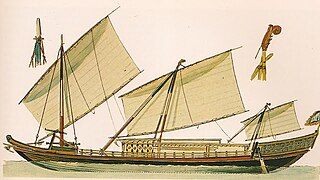
Tanja sail or tanja rig is a type of sail commonly used by the Austronesian people, particularly in Maritime Southeast Asia. It is also known as the tilted square sail, canted rectangular sail, rectangular balance lug, or balance lug sail in English. In historical sources, tanja sail is sometimes incorrectly referred to as lateen sail or simply square sail.

Bangka are various native watercraft of the Philippines. It originally referred to small double-outrigger dugout canoes used in rivers and shallow coastal waters, but since the 18th century, it has expanded to include larger lashed-lug ships, with or without outriggers. Though the term used is the same throughout the Philippines, "bangka" can refer to a very diverse range of boats specific to different regions. Bangka was also spelled as banca, panca, or panga in Spanish. It is also known archaically as sakayan.

The Austronesian vessels, are those devised or used by the Austronesian peoples of Taiwan, Maritime Southeast Asia, Micronesia, coastal New Guinea, Island Melanesia, Polynesia, and Madagascar that speak Austronesian languages. They also include indigenous ethnic minorities in Vietnam, Cambodia, Myanmar, Thailand, Hainan, the Comoros, and the Torres Strait Islands. The vessels have carried trade and migration across long distances in the region. They include monohulls, catamarans, outriggers, and proas. Sail types include a variety of crab-claw and tanja configurations.